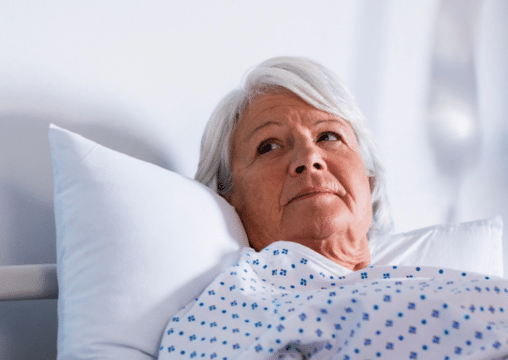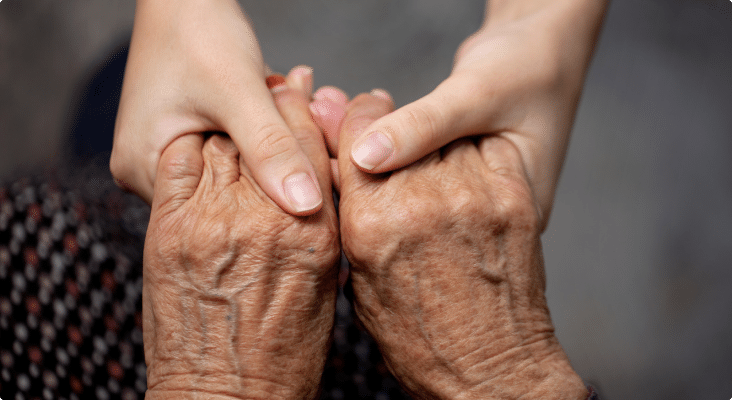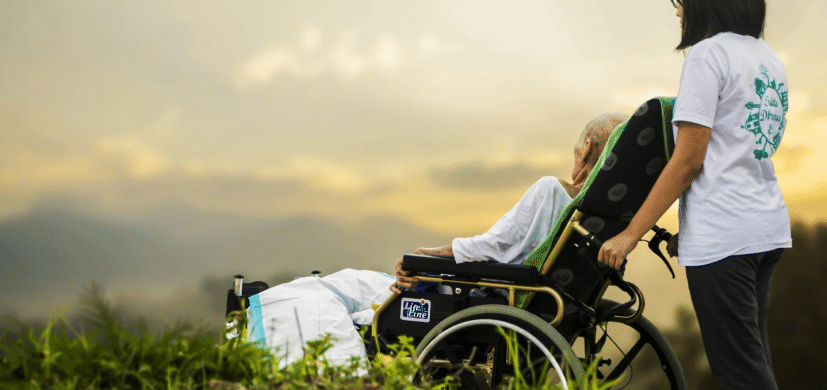Stage 2 Bedsores
Stage 2 bedsores involve skin damage that extends into deeper layers of tissue. This can result in an open wound or a blister, with red or pink tissue visible in the affected area. Treatment involves keeping the wound clean and protected, and may include medications or surgery in severe cases.

- What is a stage 2 bedsore?
- What are the signs of stage 2 bedsores?
- Who’s most at risk of developing stage 2 bedsores?
- Treatment and Prognosis of Stage 2 Bedsores
- Are there long-term complications of stage 2 bedsores?
- Are stage 2 bedsores preventable?
- Nursing Home Neglect and Abuse Laws
- How do I report suspected nursing home neglect or abuse?
- Resources for Nursing Home Residents and Family Members
The CDC reports that around 11% of nursing home residents develop bedsores—stage 2 appearing most commonly in surveys. Early developing bedsores can be easy to miss. By the time the condition has progressed to stage 2, it’s more likely to produce a visible open sore and result in severe pain. Stage 2 bedsores can continue progressing to later stages and cause additional severe health conditions.
Bedsores are frequently a sign of nursing home neglect. If an elderly or disabled family member has developed bedsores as a resident at an assisted living facility, they may be a victim of neglect or mistreatment. You can protect your loved one by learning the signs of stage 2 bedsores and what to do if they develop.
What is a stage 2 bedsore?
A bedsore is a type of ulcer. Bedsores typically occur in immobile individuals, and they’re caused by prolonged friction or pressure to the skin from lying in a bed or sitting in a wheelchair.
Bedsores are categorized in four stages according to the degree of severity. There are four stages of bedsores. Each increasing degree indicates more severe damage and more urgent health concerns.
Stage 1 bedsores are characterized by skin discoloration. The affected skin may be warm or cold to the touch, and the individual might complain of pain, burning, or itching. However, in a Stage 1 bedsore, the overlying skin is still intact.
Stage 2 bedsores have progressed to cause damage to the skin. This may present as a shallow open wound, or as a blister or scab. Besides the damage to the skin, the surrounding area is also discolored. A bedsore that has reached stage 2 is extremely sensitive, so an individual who is conscious will likely experience a high level of pain.
What are the signs of stage 2 bedsores?
Stage 2 bedsores are very noticeable and painful. They can have differences in appearance and formation, but stage 2 bedsores always affect the deeper layers of the skin. Usually, they are characterized by the presence of some type of open wound, but occasionally the skin surface may be intact even though the deeper skin tissues are damaged. Diagnosing a stage 2 pressure ulcer involves assessing its appearance, depth, and the degree of pain. For an accurate diagnosis, a doctor would need to examine the area.
The most common signs of a stage 2 bedsore include:
- Intact or ruptured blister
- Moisture or pus coming from the sore
- Discolored or irritated skin
- Dark scabs
- Skin warm to the touch
- High level of pain
Bedsores are often first diagnosed at stage 2 due to the appearance of a sore and the complaint of severe pain.
However, sometimes individuals aren’t able to feel or communicate this pain. When a patient is unconscious or lacking sensation, there’s a higher risk of stage 2 bedsores continuing to progress into the next stages.
What parts of the body are commonly affected by stage 2 bedsores?
Bedsores are caused by sustained pressure or friction from a bed or chair. Pressure reduces blood and oxygen flow, damaging or destroying the affected tissue. Thus, the body parts most commonly affected are those that sustain the most pressure from a seated or reclining position.
Bedsores are most commonly found on the:
- Buttocks
- Hips
- Legs
- Back or sides of the head
- Ankles
- Tailbone
- Lower back
- Arms
- Heels
Any body part under sustained pressure can develop bedsores. Whether the individual spends more time seated in a wheelchair or lying in a bed will impact which areas are affected.
Who’s most at risk of developing stage 2 bedsores?
Bedsores pose a high risk to the elderly and other people rendered immobile by health conditions. These painful ulcers are most common for bedridden individuals.
People at highest risk of developing bedsores include those who are:
- Unconscious
- In a coma
- Unable to feel pain
- In a wheelchair
- In a cast
Although individuals with these health conditions are most likely to develop bedsores, they can happen to anyone dealing with immobility over an extended period.
Additional health factors that increase the risk of bedsores occurring are diabetes, poor circulation, and malnutrition. Incontinence can also be a contributing factor, as damp or wet sheets add to the likeliness of bedsores developing.
When patients have an impaired ability to realize or communicate that bedsores are developing, then bedsores may not be detected in the initial stage, and are more likely to advance to stage 2 or beyond.
A primary contributing factor to stage 2 bedsores is inadequate care. Individuals residing in facilities with understaffing, poor care policies, or abusive or negligent staff are most likely to develop bedsores. This is also true for homebound individuals cared for by uneducated or negligent family members or in-home caretakers.

Treatment and Prognosis of Stage 2 Bedsores
Once bedsores have progressed to stage 2, treatment by a medical professional is necessary for a full, safe recovery.
Treatment for stage 2 bedsores involves:
- Changing body position throughout the day
- Debridement (removal of dead or infected tissue)
- Wound care
- Antibiotics
Treatment for stage 2 bedsores may also involve changing dressings or applying topical ointments.
Additional treatment steps may be necessary if any complications arise. When bedsores are identified in stage 2 and given prompt medical treatment, full recovery is possible but not guaranteed. It’s possible for some patients to only experience partial healing of the damaged tissue.
In almost all cases, a stage 2 bedsore involves a break in the surface of the skin, often in the form of an open wound. This puts the patient at high risk of infection. If an infection develops, it can complicate healing and may spread into other tissues, potentially leading to serious health issues.
Are there long-term complications of stage 2 bedsores?
Bedsores have four stages. Stage 1 can be painful, but it’s easier to miss and will likely progress to stage 2. A stage 2 bedsore is a serious health condition. If left untreated, it will continue to progress to stages 3 and 4, which pose severe health risks.
Stage 2 bedsores are characterized by damage to the epidermis and dermis, the two layers of the skin. A bedsore is categorized as stage 3 when the wound has developed into a sunken indentation. Stage 3 involves damage to the fatty tissues beneath the skin.
Stage 4 is the final and most severe bedsore progression. A stage 4 bedsore is identified by a large wound and a severe level of damage.
Left untreated, a stage 2 bedsore will continue to progress through the subsequent stages. Wound progression makes the individual susceptible to a host of health complications, including:
- Bone and joint infections
- Cancer
- Gangrene
- Necrotizing fasciitis
- Cellulitis
- Sepsis
If bedsores are left untreated for long enough, conditions like cancer and sepsis can lead to death. Likewise, if bedsores are discovered too late, treatment attempts may not be effective at reversing the damage.
Even when treatment is successful and life-threatening conditions are avoided, stage 2 bedsores can still have lasting consequences. Throughout the healing process the individual might experience:
- Pain
- Fever
- Chills
- Mental confusion
- Increased heart rate
- Weakness
The damage to tissues can take years to heal, and in some cases, it never heals entirely.

Are stage 2 bedsores preventable?
Stage 2 bedsores are preventable. Regular turning and repositioning is the best way to prevent the emergence of bedsores. Nursing home staff and other caretakers must take sufficient steps to prevent the occurrence of bedsores. Best practices for preventing bedsores include:
- Regular turning
- Correct positioning
- Good hygiene and skincare
- Good nutrition
- Clean bedding
Caretakers of patients with reduced mobility should be aware of the potential danger of bedsores and regularly inspect for signs of skin irritation and redness.
The use of additional padding in beds and wheelchairs can help reduce the risk of excessive pressure. For those in wheelchairs, sitting upright with good posture and regularly altering positions can further help reduce skin discomfort and extended pressure on the same areas. For those in beds, cushioning between the legs or ankles can help reduce pressure and friction.
Poor nutrition is often a contributing cause of bedsores, so nutritional supplements for skin health can also play a role in prevention. Suggested supplements for bedsore prevention include:
- Vitamin A
- Vitamin C
- Iron
- Zinc
Bedsores and other injuries rarely occur when a nursing home resident is given proper care. The presence of bedsores is highly concerning and a strong indication that neglect or abuse may be happening in a nursing facility.
How do I report suspected nursing home neglect or abuse?
The World Health Organization (WHO) reports that an estimated 81% of elderly Americans have either experienced or witnessed elderly abuse. This tragically high percentage confirms that nursing home abuse and neglect occur all too often.
When abuse or neglect is suspected, it should be reported immediately. Doing so will initiate an investigation and prevent further abuse from happening to your loved one and other residents.
Reporting a nursing home for abuse can be a confusing process because different states may have different avenues for reporting. It may also be challenging if family members live far away from their loved one’s facility—in that case, it’s also more difficult to notice or document signs of abuse.
Usually, nursing home abuse can be reported by contacting:
- State Department of Health
- Adult Protective Services (APD)
- The Eldercare Locator
- A nursing home abuse attorney
If severe health or safety concerns are an issue, you should immediately call 911. Emergency responders will visit the nursing home and assist if necessary.
- Last Modified April 29, 2023
- Editorial Guidelines
Dr. Patricia Shelton, MD

Education:
- University of Washington, Doctor of Medicine – MD. June 2008
- University of Washington, Bachelor of Science – BS, Jun 2003
Background:
Neuroscience and Medicine
Career:
- Dr. Shelton primarily writes content for health-related websites, but has also written test prep materials, white papers, published research articles, court documents, and more.
- Dr. Shelton teaches anatomy and physiology at the college level for the National Institutes of Health.
